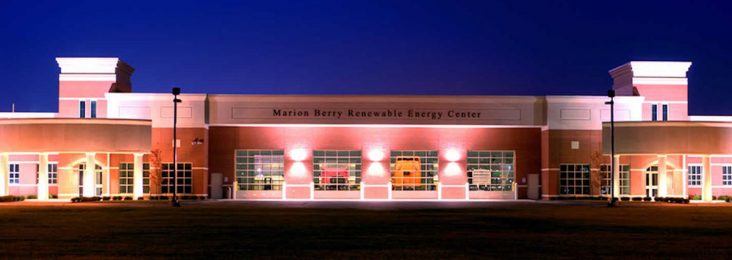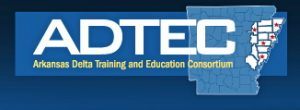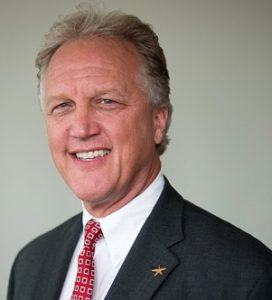Workforce programs like Marion Berry Center critical to Delta economic growth, officials say
by July 24, 2016 9:42 pm 456 views

The Marion Berry Renewable Energy Center, located on the Arkansas State University Mid-South campus in West Memphis
Glen Fenter, president of the Greater Memphis Alliance for a Competitive Workforce (GMACW), has a passion for workforce education in Memphis and the Arkansas Delta region. Likewise, he is passionate about job creation. Not just any jobs, mind you, but the kind necessary to upgrade living standards and grow the area’s economy.
Fenter is far from alone in his zeal, as several two-year colleges and other groups work toward this end – many in association with one another.
With goals similar to those of GMACW, The Arkansas Delta Training and Education Consortium (ADTEC) is a partnership that combines the resources of five eastern-Arkansas community colleges developing proven workforce models and securing grant funding for the Delta region. Members include Arkansas State University Mid-South (formerly Mid-South Community College), Arkansas Northeastern College, Arkansas State University-Newport, East Arkansas Community College, and Phillips Community College of the University of Arkansas. Mid-South also collaborates with Arkansas State University, the University of Arkansas at Fort Smith, Montana State University-Northern, and the University of Memphis to utilize facility-training programs teaching everything from diesel technology to big-bore engine repair and maintenance to all things renewable energy.
Since securing its initial $5.9 million U.S. Department of Labor grant in 2005, which focused on developing advanced manufacturing training capacity in its 12-county region, ADTEC has been awarded more than $64 million in external investments (mostly federal) to support regional workforce development initiatives.
A fitting example of the fruits of ADTEC’s labors is the Marion Berry Renewable Energy Center (MBREC), an alternative fuels educational research facility. Established through multiple grants, the MBREC is a resource unique to the region, and even surrounding states.

“ADWIRED included renewable energy initiatives which spanned 12 counties in eastern Arkansas,” Dunavin said. “The strategy supported alternative fuel training and education and enhanced agriculture production in the Arkansas Delta and fostered development of the alternative fuel industry in the region. Its benefits included creation of a Center of Excellence in Renewable Energy Technology in Arkansas County and development of a career pathway and training capacity in Renewable Energy Technology at each of the ADTEC colleges.”
MARION BERRY RENEWABLE ENERGY CENTER
Located on the ASU Mid-South Campus in West Memphis, MBREC is unlike anything on any college campus in the country, according to Fenter, a former president of Mid-South Community College and a continued advocate for the school.
“The science behind the alternative fuels portion of the facility was built on research from Montana State University-Northern in Havre, Montana, and the University of Memphis and fueled by Dr. Srikant Gir, a nationally recognized talent in alternative fuels research,” Fenter said. “The facility/equipment also lends itself nicely to training in support of programming offered by both ASU Mid-South and Southwest Tennessee Community College in Memphis, and the newly added distillation column will open up an entire new realm of opportunities for work/training in various realms of chemical processing.”
Debra West is the chancellor of ASU Mid-South. She works to build on past success, advance the Berry Center’s evolving purpose, and prepare for future challenges. She hopes the work and expenses required will pay off long-term through the development of new businesses (particularly in renewable energy), and with them, jobs to be filled by well-paid, skilled Delta-area workers.
The structure of the MBREC itself is impressive, according to West, for its energy efficiency, which goes right along with its purpose and usage.
“Recognized as an energy-friendly ‘Net Zero Energy Building,’” West said, “it has energy-saving variable speed air-conditioning units, radiant-slab heating, a recycled ‘waste heat’ water heating system, enthalpy wheel heat exchangers, and more.”

Continuing, she noted: “The Center’s advanced laboratories support biofuel production technologies, analyze fuel and lubricant properties, examine effects of biofuels and biolubricants on engine performance and durability, and measure the effects of biofuels and biolubricants on transportation and agricultural equipment. The building also houses a biofuel production facility that converts biomass to syngas and fuels, a second-generation micro-biodiesel refinery, and more.
“Its workforce/education pathways in diesel/biodiesel technology and renewable energy technology (again, developed through ADTEC grants from the U.S. Department of Labor) include high school concurrent credit programs, community college certificates and degrees, and baccalaureate degrees.”
FILLING WORKFORCE GAPS
“The Marion Berry Center and similar facilities across our state are critical components of tooling Arkansas’ workforce to address the ongoing skills gap,” said Bill Stovall, executive director of the Arkansas Community Colleges.
Composed of 22 comprehensive community and technical institutions in the state, the non-profit association focuses on maximizing economic efficiency, professional development, and advocacy.
“Program offerings like this at our community colleges, complimented with a curriculum designed to develop Common Employability Skills are essential to position Arkansas for 21st century economic prosperity.”
In a trickle-down effect, MBREC is a win-win for the area, according to West. It supports entrepreneurs, workforce training, and applied research in the area of renewable energy and related process industries.
FUNDING STRUGGLES
While the passion for creating a skilled workforce flows abundantly in programs like MBREC, funding can be a challenge. Open since 2012, MBREC was constructed with money from a $2 million grant from the U.S. Department of Commerce’s Economic Development Administration. It was programmed through an additional $1.2 million from the U.S. Department of Labor. However, without stable, continued funding, the program and those like it are threatened.
“The issue for Mid-South is funding the talent and expertise required to maximize the impact of the facility and its technology for the region,” said Fenter, who commended the school and West for their efforts to keep the programs going while expressing hope that state efforts will reprioritize funding practices in order to sustain programs like MBREC. “It is difficult for programs like ASU Mid-South and others to reconcile nationally recognized grant-funded workforce programming with a state support model that has remained flat over the past decade.”
“Two of every three jobs require more than high school and less than a baccalaureate degree,” Fenter said. “Consequently, states that commit to funding educational models that include post-secondary, industry-driven credential programming in their workforce development strategies will see consistent economic growth in the coming years. Arkansas is to be commended for its consistently robust pattern of support for K-12 programming over the last decade, but it has failed to support post-secondary workforce programs with the same zeal. That’s getting half the model right, but stopping well short of reaping the maximum return on investment.”
Fenter added: “GMACW has a tremendous responsibility to create new strategies to connect employers and educational providers in a way that substantively improves how we’ve traditionally responded to the education and training needs of our workforce. I’m encouraged daily by our teams’ awareness of how to deliver on our mission: to close the skills gap by driving better alignment of training and education programs with employers’ skill requirements and delivering innovative strategies and tools to help Memphis citizens successfully navigate career pathways. Clearly, there are many community/technical colleges in Arkansas ready to provide similar programming and leadership for their regions; they simply need the appropriate resources to do so. If Arkansas hopes to develop a consistent pattern of career-based job growth and retention in the future, significantly improving funding for two-year colleges and their workforce missions will be imperative.”
NEW ARKANSAS WORKFORCE GRANTS
Stovall praised a recent Arkansas move to provide $8 million in funding for regional workforce grants. Stovall speaks of 2015 legislation known as the Workforce Initiative Act Regional Workforce Grant Program. Intended to create a statewide workforce education infrastructure, the program will enable students in Arkansas universities, community colleges and secondary centers to participate in career and technical education programs developed with input from area employers.
According to the Arkansas Department of Higher Education, the legislation will help Arkansas compete as it prioritizes and addresses the workforce education needs of our state.
“Programs offering short-term career and technical training, as well as, those producing Certificates of Proficiency, Technical Certificates, Associate of Applied Science, or similar degrees, and Bachelor of Applied Science, or similar degrees, are critical to the success of Arkansas’ economic development,” notes the ADHE about the program.
Despite the challenges, West presses on, revising intentions to match the fluctuating market for alternative fuels and creatively working toward funding stability and support for students in the program.
“When the Center was built in 2012, the rising cost of oil was a huge concern. The emphasis on alternative energy was at its peak. With gas prices now dramatically lower, the urgency surrounding the development of alternative fuels has diminished,” West said. “However, there is still industry demand in this region for trained process technicians not only in oil and gas, but also in food production, chemical processing, etc. That demand is not going away any time soon. Therefore, we remain focused on developing the educational component of this center to train individuals to work in these industries.”
This May, the Center began enrolling its second class of process technology students. Moving forward, West says they will continue to help potential students understand the field and the types of jobs available to them as graduates – high-paying jobs with excellent benefits and competitive salaries.
“The average salary for an entry-level worker with a two-year associate degree is $45,000+ a year. Process industries include everything from chemical refining, oil and gas exploration and production, food and beverage processing, power generation, pharmaceuticals, cosmetics, paper and pulp production, and water treatment. The Marion Berry Center is a high-tech education and training facility with production capabilities and its own operational micro-refinery,” she explained. “The demand is worldwide and projected to grow. Now is a great time to enter the field that current students describe as fast-paced and exciting.”
“With the state-of-the art equipment we have in this facility – which, candidly, can’t be found anywhere else – we believe there continues to be opportunity for partnerships with universities, and with industry, to provide advanced training and production support. Our plan is to continue to explore all avenues with regard to how we best utilize this tremendous resource we have on our campus.”
